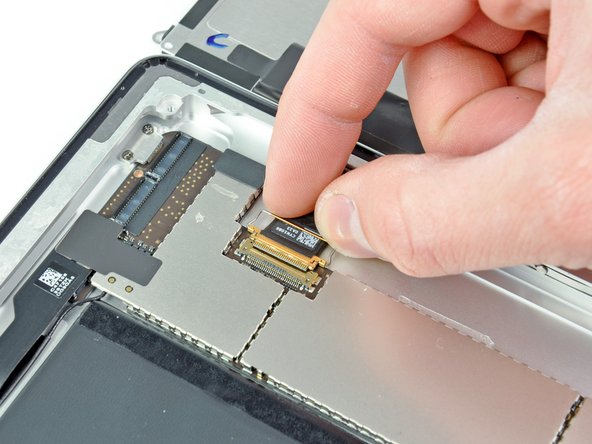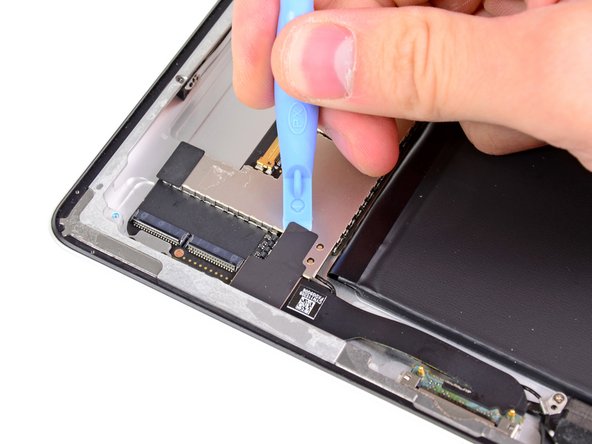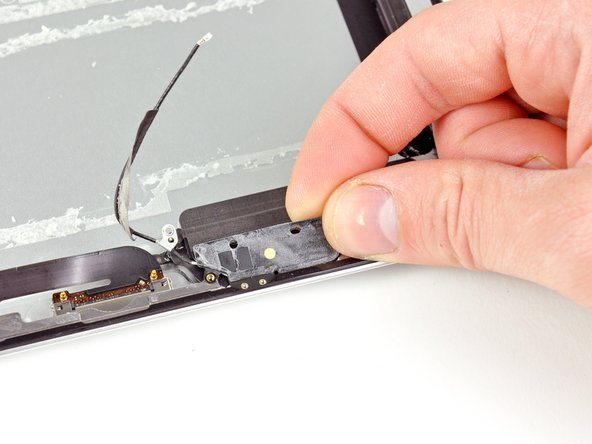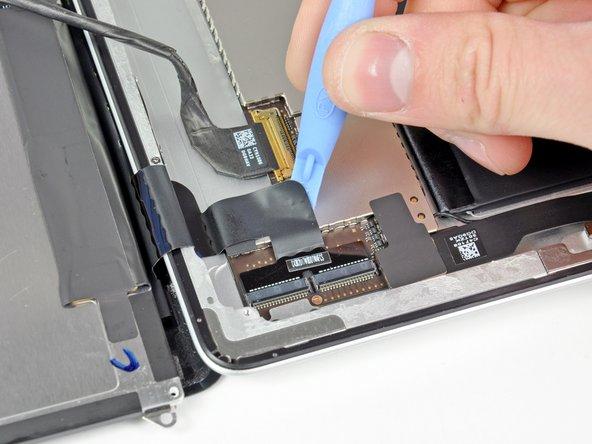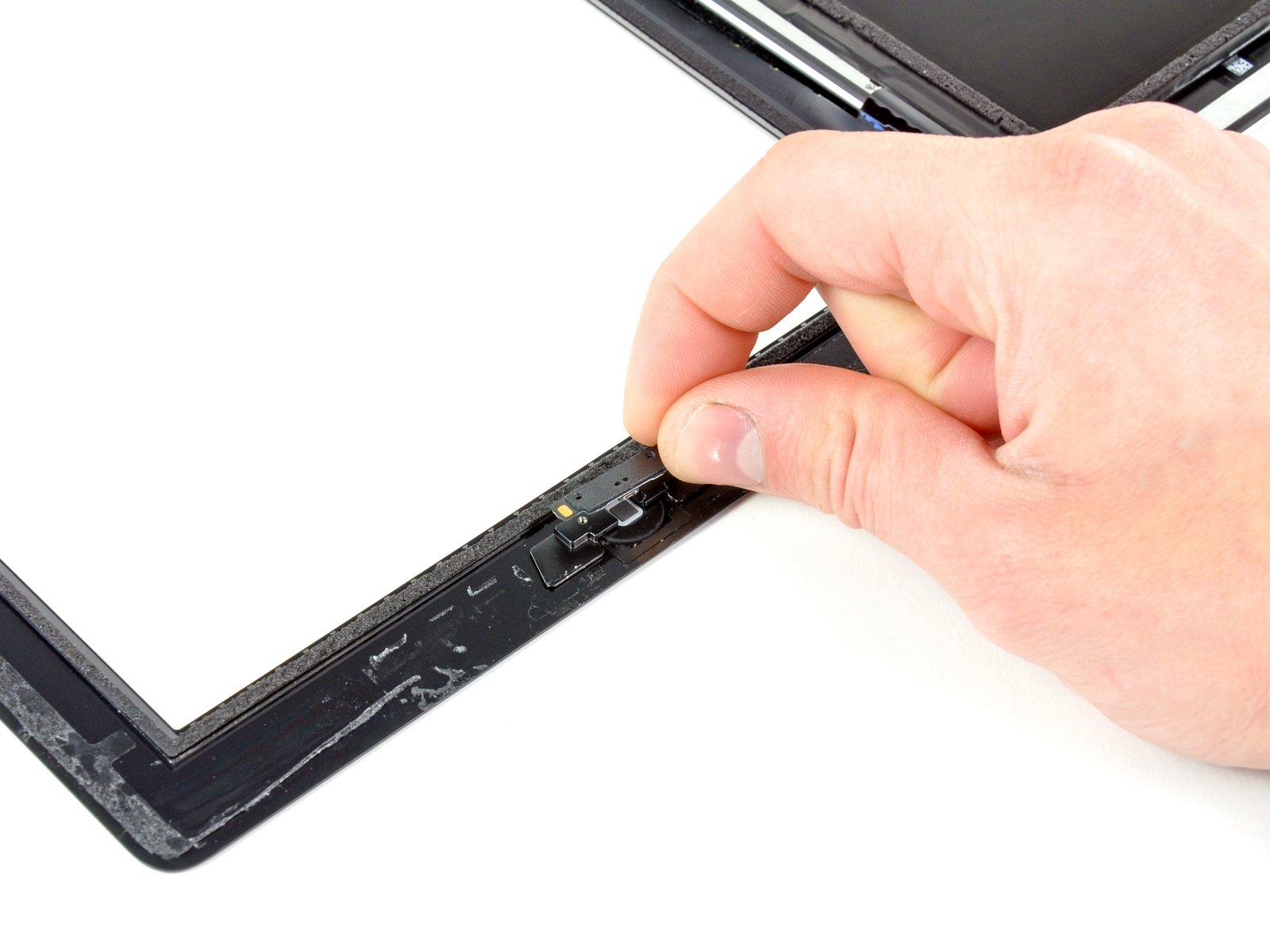DIY Guide to Replace iPad Wi-Fi EMC 2415 Speaker Assembly
Duration: 45 minutes
Steps: 58 Steps
Hey there! Just a quick heads-up: be careful when you’re working on your device. It’s a good idea to keep your workspace organized and make sure you’re using the right tools. If you need a hand, you can always schedule a repair!
Ready to bring your audio back to life? Dive into this guide to swap out that worn-out speaker assembly and get back to jamming out in no time! If you need help, you can always schedule a repair.
Step 1
It’s a good idea to give your microwave a little TLC before you dive in. Trust us, that sticky stuff on the bottom could end up making friends with your iOpener, and we don’t want that!
– Pop that iOpener right in the middle of the microwave and let it warm up!
Tools Used
Step 2
Keep a close eye on the iOpener during your repair adventure! Getting it too hot can lead to a dramatic burst—yikes! So, let’s keep the temperature below 100˚C (212˚F).
If the iOpener looks like it’s puffing up, just step back and don’t touch it.
If the middle of the iOpener is still too toasty to handle, just hang tight! Keep using it while it cools down a bit before you reheat. A perfectly warmed iOpener will stay cozy for about 10 minutes.
– Give your iOpener a cozy thirty-second spa session in the microwave. It’s a warm-up that sets the stage for a smooth repair!
– As you work your magic on the device, keep an eye on the iOpener. If it starts to cool down, just pop it back in the microwave for another quick thirty seconds. You’re doing great!
Tools Used
Step 3
The iOpener is going to be pretty toasty, so handle it with care! An oven mitt can be your best buddy here if you need it.
– Carefully take the iOpener out of the microwave, gripping it by one of the two flat ends to steer clear of the hot center. Keep it cool, folks!
Tools Used
Step 4
No microwave? No problem! Just pop your iOpener into some boiling water and let the magic happen.
– Grab a pot or pan and fill it up with enough water to give your iOpener a nice warm bath.
– Heat that water until it’s bubbling away, then go ahead and turn off the heat.
– Gently place the iOpener in the hot water for about 2-3 minutes. Make sure it’s taking a nice dip and is fully submerged!
– Using some tongs, carefully fish out the warm iOpener from its steamy spa.
– Give it a thorough drying with a towel, ensuring it’s all nice and cozy.
– Your iOpener is now all set for action! If it needs a little more warmth later on, just heat the water back up to a boil, turn off the heat, and let it soak again for 2-3 minutes.
Tools Used
Step 5
Put on those safety glasses to keep your peepers safe, and watch out for that LCD screen—it’s more delicate than it looks!
– If your display glass has taken a hit, let’s keep it from shattering further and protect those fingers while you work your magic—grab some tape and cover that glass up!
– Lay down some overlapping strips of clear packing tape over your iPad’s display until the entire face is shielded. Think of it as giving your device a cozy blanket!
– Now, just do your best to follow the rest of the guide as laid out. Keep in mind, once that glass is cracked, it might just decide to keep cracking. You may find it helpful to use a metal prying tool to gently scoop out the broken pieces. If you need help, you can always schedule a repair.
Step 6
Just a friendly heads-up: as you might be dealing with some fragile glass during this process, we highly suggest putting on a pair of safety glasses to shield your eyes from any unexpected flying pieces. Better safe than sorry!
– Place the iOpener flat against the right edge of your iPad, making sure it’s snug and cozy for a solid connection with the iPad’s surface.
– Give it a little time to work its magic—let the bag rest on the iPad for about 90 seconds before diving into opening that front panel.
Tools Used
Step 7
Getting that wedged tip of the opening tool between the glass and plastic might take a bit of elbow grease. Just take your time and be gentle, wiggling the plastic opening tool back and forth as needed. You’ve got this!
– Notice that there’s a tiny little gap in the iPad’s adhesive ring at the upper right corner, about 2.0 inches (~5 cm) from the top. That’s your entry point! Let’s take advantage of this.
– Get ready to line up your tool with the mute button. Gently slide the tip of a plastic opening tool into that gap between the front glass and the plastic bezel. Just nudge it in a bit, enough to open the crack wider.
Step 9
– With the plastic opening tool snugly positioned between the front glass and the plastic bezel, gently slide a plastic opening pick into that cozy little gap right next to your trusty tool. You’ve got this!
Step 10
– Take out the plastic opening tool from your iPad and gently slide the opening pick further under the front glass, aiming for a depth of about 0.5 inches. You’re doing great!
Step 12
The adhesive is super strong, so you might need to channel your inner superhero. Take it slow and steady!
If you can spot the tip of the opening pick peeking out from under the front glass, gently pull it out a bit. While using the pick this deep won’t cause any harm, it might leave some adhesive residue on the LCD, so just a heads up!
– While the iOpener is warming up the bottom edge, let’s get started on peeling away the adhesive from the right edge of your iPad.
– Gently slide the opening pick down the edge of the iPad, and watch that adhesive give way as you go!
Tools Used
Step 13
As you work on releasing that adhesive, you might find it helpful to slide the heated iOpener back onto the right edge of your iPad. Just keep in mind how long it’s been cooling off while you’ve been busy. We’ve got this!
– If your opening pick is feeling a bit clingy with that adhesive, just give it a gentle ‘roll’ along the side of the iPad. Keep it moving to help free up the sticky situation.
Tools Used
Step 14
– Before you dive in and remove that first opening pick from the bottom corner of the iPad, slide a second pick under the right edge of the front glass. This little buddy will help keep the adhesive from getting too clingy again!
– Give that iOpener a little love with some re-heating, then place it at the top edge of the iPad. You’re doing great!
Tools Used
Step 15
Hey there! Just a heads up: the Wi-Fi antenna is snugly fitted to the bottom right corner of the iPad’s rear case with some screws and a cable. Given how it’s positioned, it’s super important to handle it gently—otherwise, you might end up causing some permanent damage to the antenna. So, take your time and be careful!
– Alright, folks, it’s time to proceed with a little extra care. We’ve got some delicate work ahead!
– You’ll need to gently detach the adhesive holding the antenna to the front panel. Just be sure to avoid any damage to the sensitive parts connecting the antenna to the bottom of your iPad. Keep a steady hand and follow the upcoming steps closely!
Step 16
Keep that pick from sliding past the bottom right corner! Going too far could put a dent in your Wi-Fi antenna, and we don’t want that!
– Gently glide the opening pick around the bottom right corner of the iPad to break free the adhesive holding it down. You’re doing great!
Step 17
Take it easy while sliding the opening pick along the bottom right edge of the front panel. The Wi-Fi antenna is sneaky and hangs out near the corner, so be careful! If the adhesive gets too wild, it can easily get cut. You’ve got this!
Just give that pick a little wiggle and don’t yank it out completely! Keep about 1/8″ (3 mm) of the tip snugly under the front glass for a smooth operation.
– Gently glide the tip of your opening pick along the bottom edge of the iPad to free up the adhesive over the Wi-Fi antenna. You’re doing great!
Step 18
– Alright, once you’ve gracefully glided past the Wi-Fi antenna (about 3 inches from the right edge, or snugly next to the home button), it’s time to slide that opening pick back in all the way. You’ve got this!
– Now, give that pick a little nudge to the right and watch as the adhesive holding the Wi-Fi antenna to the front glass lets go. Easy peasy!
Step 19
Hey there! Remember, no more than a minute in the heat for that iOpener, and let it chill for at least two minutes before you give it another go. Keep it cool and safe, buddy!
– Keep peeling back that adhesive along the bottom of the iPad! Gently pull the opening pick out just enough to glide around the home button, then slide it back in until it’s about 1/2 inch (10 mm) deep, once you’re past the home button. You’ve got this!
Tools Used
Step 20
– Keep peeling that adhesive along the bottom edge of the iPad until it’s all gone! You’re doing great!
– Pop the opening pick right under the front glass near the home button and leave it there—it’s your trusty sidekick for this adventure!
Step 22
If the adhesive has taken a chill pill, just swap in the iOpener along the top edge and keep on going. If the iOpener feels a bit too cool, give it a little heat boost!
– Gently glide the opening pick along the top edge of your iPad, giving it a little tug to navigate around the front-facing camera bracket.
– The adhesive in this area is quite strong, so you might need to apply some elbow grease. Take your time and be careful—let’s avoid any slips that could lead to a mishap with your iPad.
– If your opening pick is feeling a bit stuck in that sticky adhesive, just ‘roll’ the pick as demonstrated in step 9.
Tools Used
Step 23
If the adhesive is feeling cozy and warm, go ahead and take the iOpener off the iPad for a bit of ease. But if it’s still hanging on tight, give the iOpener another heat-up and place it on the left edge while you work your magic.
– Keep peeling away the adhesive at the top edge of your iPad, then gently slide that trusty opening pick around the top left corner.
Tools Used
Step 24
The digitizer cable is hanging out around 2″ (50 mm) from the bottom of your iPad. When you reach about 2.25″ (60 mm) from the bottom, it’s time to stop sliding that pick and give yourself a pat on the back!
– Gently slide the opening pick along the left edge of your iPad, letting it work its magic on the adhesive as you go. The adhesive here is pretty thin thanks to the digitizer running along the entire left side. Just keep the pick shallow (no more than 1/2 inch or 10 mm) to avoid any accidental damage to that digitizer. You’ve got this!
Step 25
Be super careful here! The bottom of the digitizer cable is only about 1 inch (25 mm) away from the bottom of your iPad. Take your time and work gently to avoid cutting this cable.
– With your trusty opening pick still nestled under the bottom edge of the iPad, gently free the adhesive from the bottom left corner. You’ve got this!
Step 26
– Grab one of those handy opening picks and gently pry up the bottom right corner of your iPad. Then, give it a little nudge with your fingers to lift it up. You’re doing great!
Step 27
Watch out for any stubborn adhesive that might still be clinging on, and grab an opening pick to gently slice through any sticky spots holding that front panel in place.
– Grab your iPad by the top and bottom right corners and gently twist that front glass away from the device like you’re unveiling a surprise!
– When putting everything back together, don’t forget to give that LCD a little love! Use a microfiber cloth and some compressed air to whisk away any pesky dust or fingerprints before you set the glass back in place.
Step 28
– Get ready to tackle those four 2.0 mm Phillips screws that are holding the LCD snug against the rear case. Let’s get that screen freed up!
Step 29
To get to those front panel ribbon cables, which are cozily tucked away under the LCD, you’ll need to give the LCD a little flip and move it aside for a moment. Easy peasy!
– Gently lift the LCD from the edge nearest to the volume buttons and carefully flip it away from the rear case—just like flipping a page in your favorite book.
– Place the LCD face down on the front panel, giving it a comfy spot to rest.
Step 30
Just a friendly reminder: when you’re prying those hinged retaining flaps, make sure you’re not tugging on the sockets themselves!
The retaining flaps are marked in red in the second image for your convenience.
– Gently use the edge of a plastic opening tool to lift up those little retaining flaps on the two digitizer ribbon cable ZIF sockets. You’ve got this!
Step 31
– Grab a plastic opening tool and gently work it along the edge to lift that digitizer cable off the shields on the logic board. You’re doing great!
– Now, with a gentle tug, carefully peel the digitizer cable away from the adhesive that’s holding it snug against the side of the rear case. Easy does it!
Step 32
– Gently wiggle that digitizer ribbon cable and pull it straight out from its cozy sockets on the logic board. You’ve got this!
Step 33
To get that front panel assembly off, you’ll want to gently slide the ribbon cable out from between the case and the LCD. Just give the LCD a little nudge to create some space. You’ve got this!
– Gently lift the LCD from its long edge that’s farthest from the digitizer cable and smoothly flip it towards the rear case—think of it like closing a book with care.
– While keeping the LCD elevated, carefully slide the front panel away from the iPad. Watch out for that digitizer cable; it can be a little clingy to the rear case or LCD.
Step 34
To dive into the iPad’s inner workings, let’s gently pop the LCD out of the case.
– Gently lift the LCD from the edge nearest to the volume buttons and flip it out of the rear case—think of it as turning the page of your favorite book!
– Carefully set the LCD face down on a clean surface. Placing it on a soft cloth is a great idea to keep those scratches away.
Step 35
Watch out! When you’re disconnecting that connector, give it a gentle nudge sideways instead of pulling it straight up. We want to keep everything intact and happy!
– Grab your trusty plastic opening tool and gently nudge the display data cable lock upwards. You got this!
– Now, with a gentle tug, pull that display data cable out of its cozy socket. Easy peasy!
Step 36
– Gently detach the LCD assembly from the back panel assembly.
Step 37
– If there’s a tape covering the end of the dock connector cable, grab a plastic opening tool to gently peel it away.
– Next up, use the edge of that trusty plastic opening tool to carefully lift the dock connector cable’s connector out of its cozy home on the logic board.
– Now, go ahead and peel the dock connector ribbon cable off the rear panel like you’re unwrapping a gift!
Step 38
Take it easy and make sure to gently pry just the connector, leaving the logic board socket alone. We wouldn’t want to accidentally turn that socket into a puzzle piece!
– Gently lift the speaker cable connector straight up from its cozy spot on the logic board.
Step 39
Remember to gently lift the hinged retaining flap upward—leave the socket alone!
– Grab your trusty plastic opening tool and gently nudge up the little retaining flap on the headphone jack and front camera cable ZIF socket. It’s like a tiny secret door waiting to be opened!
– Once that’s done, carefully peel away the headphone jack and front camera cable from the rear case. You got this!
Step 40
– Gently wiggle the headphone jack and front camera ribbon cable out of its cozy little home on the logic board. No need to rush, just take it nice and easy!
Step 41
Keep that cable level as you unplug it, no need for any acrobatics!
– Grab a plastic opening tool and gently pry up the retainer that’s holding the control board cable connector snugly in its spot on the logic board.
– Once it’s popped up, give that connector a little tug to pull it away from the logic board’s socket.
Step 42
– Unscrew those two 2.1 mm Phillips screws that are keeping the logic board bracket snugly attached to the rear case, right by the digitizer cable socket. You’ve got this!
– Gently lift the logic board bracket off the rear case and set it aside. You’re making great progress!
Step 43
– Time to say goodbye to those last three pesky 2.6 mm Phillips screws holding the logic board in place! Let’s get them out and make some room for the magic to happen.
Step 44
– Gently slide the edge of a plastic opening tool under the logic board and lift it up from the adhesive holding it to the rear case. Remember, patience is key here—you’re doing great!
Step 45
Hold your horses! Don’t yank it out just yet—there’s still an antenna cable hanging on for dear life.
– Gently lift the logic board out of the rear case and give it a little tilt towards the battery. You’re doing great!
Step 46
– Gently slide the edge of a plastic opening tool under the Wi-Fi antenna connector and lift it up from its cozy home on the logic board.
– Carefully detach the logic board from the iPad 2 and set it aside.
Step 47
Hey there! Just a friendly reminder to keep an eye on that iOpener during your repair adventure. Give it a cool-down break of at least two minutes before reheating, and remember, no more than one minute in the microwave! Let’s keep things safe and steady!
– Pop that iOpener in the microwave for a quick minute to get it nice and toasty!
– Once it’s warmed up, place the iOpener on the back of your iPad, just a smidge to the right of center (that’s the side away from the rear-facing camera). Let it chill there for 90 seconds to loosen up that pesky battery adhesive.
– Now, slide the iOpener to the center of the back of the iPad and let it sit for another 90 seconds. Patience is key!
– Finally, move the iOpener over to the left edge (the side with the rear-facing camera) and give it another 90 seconds of quality time. You’re doing great!
Tools Used
Step 48
If you’re having a tough time getting that adhesive to budge, give the rear panel a little extra warmth and give it another go!
– Kick things off by tackling the battery cell that’s nearest to the dock connector. Slide a plastic opening tool gently under the edge of that battery, right by the logic board area, to create just enough space to slide in the flat end of a spudger.
– Next, take that spudger and glide the flat end along the two long sides of each battery cell, ensuring you completely detach them from the adhesive holding them snugly to the rear case.
Tools Used
Step 49
Take it easy on that battery connector board – no extreme bending, please! And when you’re gently lifting around the screw post on the aluminum rear case, just keep it cool and steady.
– Before you get your prying game on with that middle battery cell, gently use the edge of a plastic opening tool to lift the battery connector board away from the rear panel. You’ve got this!
Step 50
– Now, grab your trusty spudger and gently work your magic to peel away the adhesive along the longer sides of the middle battery cell. Take your time, and let the spudger do its thing!
– Once you’ve tackled that, repeat the same smooth moves for the last battery cell. If things get a little sticky, don’t hesitate to give the case a little heat boost!
Tools Used
Step 51
– Gently pop the battery out from the back panel and set it free from the iPad 2.
Step 52
– Gently lift up those dock connector and speaker cables to uncover the hidden Wi-Fi antenna cable underneath. You’ve got this!
– Carefully detach the Wi-Fi antenna cable from the rear panel. It’s like unwrapping a present, but way cooler!
Step 53
– Unscrew those four little screws right there!
Step 54
– Gently peel the Wi-Fi antenna away from the speaker enclosure and take it out of the iPad 2. You’re doing great!
Step 55
Just a friendly reminder to keep those tiny EMI foam rings snug on the dock connector cable!
– Gently peel the dock connector cable away from the speaker cable. Take your time, and you’ll be on your way to a smooth repair in no time!
Step 56
– Grab a plastic opening tool and gently lift the edge of that big ol’ tape strip holding the speaker assembly snug against the rear panel.
– Now, use your fingers to peel away that tape from the speaker assembly like a pro!
Step 57
– Unscrew those two little screws right there!
Step 58
– Grab a plastic opening tool and gently nudge the speaker assembly out from beneath the right side of the rear panel. You’ve got this!
– Carefully lift the speaker assembly out of the iPad 2. You’re on your way to a successful repair!


































































